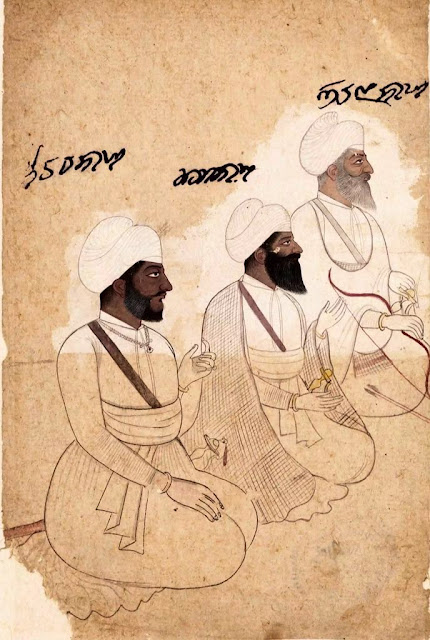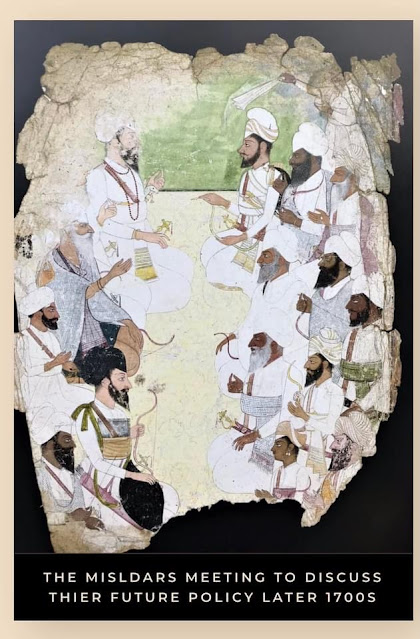The sanctuary at Hari Ke Patan was a place of refuge for the Sikhs including the Bhangi Misl Jathedars.
Hari Ke Patan, which is shown below now has a bird sanctuary but in 1735 it was a place of refuge for the Sikhs under Nawab Kapur Singh Virk when they left Amritsar and retired to this area…this included the 65 Jathas of which 18 were lead by Bhangi Misl Jathedars.
It’s important to note that Nawab Kapur Singh, supreme leader of the Sikhs chose to marry his own niece to Sardar Lehna Singh Kahlon of the Bhangi Misl, who was one of these early Jathedars and would have fought alongside him.
The Mughal Governor of Punjab Zakariya Khan organised moving columns called Gashti Fauj mounted on horses and camels to pursue the Sikhs.
The Sikhs who fell into the hands of the Mughals were sent to Lahore to be executed at a place which the Sikhs called Shahid Ganj.
The Sikhs had to resort to the Lakhi Jungle lying between Ferozepur and Bhatinda, where they experienced hard times due to the scarcity of food and water.
They were trapped as Rae Kalha of Raekot controlled the whole area lying to the south of River Satluj including the parganahs of Baddowal, Basian, Jagroan, Jhandala, Ludhiana, Talwandi…and the Bhattis dominated the Bhatinda-Sirsa region.
Then luckily for the Sikhs Nadir Shah of Persia invaded India in 1739, which caused the administrative machinery to collapse with many cities and villages reduced to ashes!
Kapur Singh led the Sikhs to seize this opportunity to gather booty and punish their enemies - the Sikhs blocked roads and pathways, and plundered large parts of the country.
They built a small fort at Dallewal to store their booty…small parties of the Sikhs were sent to punish such persons as reported their whereabouts to the Mughal government.
After Nadir Shah retired back to Persia, the Mughal Governor Zakariya Khan found the Punjab in ruins. He razed the Sikh fort of Dallewal to the ground. Large numbers of Sikhs were again executed at Shahid Ganj.
The Sikhs fled away from the Punjab and went to Malwa…but the Majha Sikhs were driven away by the Brars.
In Sirhind, the Sikhs seized many villages but Emperor Muhammad Shah sent Azimullah Khan to chastise the Sikhs. They were driven away into the Lakhi Jungle.
Zakariya Khan died on 1st July 1745, and was succeeded by weaklings - Abdullah, Yahiya Khan and Shahnawaz.
Thousands of young Jats of the Majha region of Punjab became Sikhs, enticed by the prospect of robbery rather then their life of toil and tears on the land.
Nawab Kapur Singh divided them into twenty-five bands, each consisting of about 100 young men under the command of a leader. This was the birth of a system of general confederation for defence and offence.
In 1747, the Sikhs suffered what became known as the Smaller Holocaust (Chota Gallughara) after they had murdered Jaspat Rai in charge of eMinabad District - his brother Lakhpat Rai who was the Chief Minister of Lahore vowed vengeance on the Sikhs…Kapur Singh led the survivors into Malwa.
A civil war started in Punjab with Yahiya Khans younger brother Shahnawaz revolting against him - this gave the Sikhs an opportunity to gain strength and they erected a mud fort called Ram Rauni at Amritsar.
Persian King Nadir Shah was murdered in June 1747, and his general Ahmad Shah Abdal assumed Kingship of Afghanistan as Ahmad Shah Durrani. He needed money to consolidate his position and decided to invade India which he did in December 1747.
He was defeated by the Mughals near Sirhind on 11th March 1748 at the Battle of Manupur, and his victor was the much dreaded by the Sikhs Muin-Ul-Mulk popularly known as Mir Mannu….who was appointed viceroy of the Punjab…both the Afghan invasion and Muin’s appointment alarmed the Sikhs.
Nawab Kapur Singh decided to create the Dal Khalsa on 1st April 1748 - with the 65 fighting groups now grouped into eleven Misls or confederacies.
Each of the Misls were placed under a Sardar with Sardar Jassa Singh Ahluwalia under supreme command.
The Dal Khalsa were divided into the Buddha Dal (more experienced fighting men) and the Taruna Dal (the younger and possibly more reckless men.).
The Buddha Dal were : Ahluwalia, Dallewalia, Faizullapuria, Karorasinghia, Nishanwala and Shahid.
The Taruna Dal were : Bhangi, Kanhiya, Nakai, Ramgharia and Sukarchakia.
The Taruna Dal were given the more dangerous western Muslim Punjab area from where invaders would come …but this worked out to their advantage and they were to conquer much Muslim territories with the Bhangi Misl emerging as the most powerful until the later emergence of the Kanhaiya Misl and Sukarchakia Misl when it became a 3 way contest - ultimately after much fighting when the Sikhs started their conquests in the 1760s with the Bhangi Misl taking Lahore for good in 1765 it was all one way for the Sikhs who stopped all the invasions winning every battle except the Vadda Ghallughara in 1762 and enjoyed peace taking Delhi in 1783…until Ahmad Shah Durrani’s grandson Shah Zaman briefly invaded in 1797…after this saw the rise of Maharaja Ranjit Singh and full sovereignty for the Punjabi people who until then had just witnessed invasions - there were some SEVENTY invasions through the Punjab in the same time period that the British had William the Conquerers one invasion…to 1750s.
The Sikhs built a Gurdwara at the place where the Martyrs were executed in Lahore :
https://www.youtube.com/watch?v=T2JnlctzwK8
The Sikhs also built Gurdwaras in the Lakhi Jungle area which have also been previously visited by 4 Sikh Gurus :
https://www.youtube.com/watch?v=PqvgMFE6X4c




Comments
Post a Comment